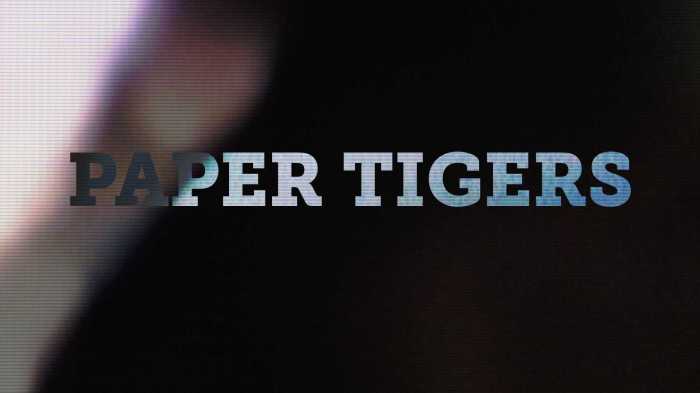Paper tigers by wesley yang – Wesley Yang’s concept of “paper tigers” offers a fascinating lens through which to examine the deceptive nature of perceived threats, inviting us to question the superficial strength that often masks underlying weaknesses.
Paper tigers, characterized by their inflated appearance and inherent fragility, can profoundly impact individuals and society, shaping perceptions, behaviors, and even broader societal consequences.
Definition and Origin

In his essay “The Paper Tigers,” Wesley Yang defines “paper tigers” as entities or ideas that appear formidable but are ultimately weak or ineffectual.
Yang argues that the term originated in Chinese Communist propaganda during the Cold War, where it was used to describe the United States as a seemingly powerful but ultimately vulnerable enemy.
Historical Context
Yang traces the use of the term “paper tiger” back to the Chinese philosopher Lao Tzu, who wrote in the 6th century BC that “a tiger drawn on paper is not a real tiger.” This suggests that the concept of “paper tigers” has been around for centuries, referring to the idea that something that appears threatening may not be as dangerous as it seems.
Examples
Yang provides several examples of “paper tigers” in modern society, including the Soviet Union, which appeared powerful but ultimately collapsed; the Chinese Communist Party, which maintains a tight grip on power but faces growing internal dissent; and the United States, which is seen as a global superpower but faces challenges from rising powers like China.
Characteristics of Paper Tigers

Paper tigers, unlike genuine threats, possess a superficial appearance of strength that masks their underlying weaknesses. These characteristics distinguish them from real threats and contribute to their deceptive nature.
One key attribute of paper tigers is their inflated reputation or image. They may project an aura of power or influence that is not supported by their actual capabilities. This inflated image can be created through propaganda, media manipulation, or carefully crafted narratives.
Superficial Strength
Paper tigers often exhibit a facade of strength that is not rooted in substance. Their power may rely on external factors, such as political alliances or economic advantages, rather than on intrinsic capabilities or merits. When faced with real challenges, these external supports can crumble, revealing their true weakness.
Underlying Weaknesses
Beneath the superficial strength of paper tigers lie inherent vulnerabilities. These weaknesses may include a lack of internal cohesion, poor leadership, or a reliance on outdated strategies. When these weaknesses are exposed, the paper tiger’s facade collapses, and their true nature becomes apparent.
Impact on Individuals and Society

Paper tigers can profoundly impact individuals and society. Their false appearance of strength can lead to distorted perceptions and behaviors, with far-reaching consequences.
Individual Perceptions and Behaviors
Individuals exposed to paper tigers may develop inflated perceptions of their own abilities or the challenges they face. This can lead to overconfidence, recklessness, or avoidance of genuine threats.
Paper Tigers by Wesley Yang argues that China is not as powerful as it seems. The author cites the country’s economic problems and lack of innovation. Yang also points to the fact that China is facing a demographic crisis. As a result, he believes that China is not a threat to the United States.
Like en la barberia no se llora , Yang’s analysis is based on a careful examination of the facts. He does not rely on stereotypes or wishful thinking. As a result, his conclusions are persuasive and well-supported.
Societal Consequences
At a societal level, reliance on paper tigers can foster complacency and a false sense of security. It can also undermine trust in institutions and lead to poor decision-making, with potential consequences for economic stability, national security, and social cohesion.
Identifying Paper Tigers

Recognizing paper tigers is crucial to avoid falling prey to their deceptive appearances. Critical thinking and evidence-based decision-making are essential tools in this process.
To identify potential paper tigers, consider the following strategies:
Examine Credibility
- Evaluate the source of information: Is it reputable, unbiased, and has a track record of accuracy?
- Consider the author’s credentials and expertise in the subject matter.
- Look for evidence of bias or agenda that may influence the information presented.
Analyze Evidence
- Examine the supporting evidence provided: Is it sufficient, relevant, and reliable?
- Consider whether the evidence is based on empirical data, anecdotal evidence, or personal opinion.
- Evaluate the methodology used to collect and analyze the evidence: Is it rigorous and transparent?
Apply Critical Thinking
- Question assumptions and biases: Are there any hidden assumptions or preconceptions influencing the information?
- Consider alternative perspectives and interpretations: Are there other viewpoints or evidence that contradict the presented information?
- Make informed decisions: Based on your critical analysis, determine whether the information presented is credible and reliable or should be considered a potential paper tiger.
Case Studies

Paper tigers manifest in various contexts, each with unique contributing factors. By examining real-world examples, we can better understand the dynamics that lead to their rise and fall.
Political Paper Tigers, Paper tigers by wesley yang
Political paper tigers often arise when leaders or organizations project an image of strength or authority that does not reflect their true capabilities. This can be due to factors such as overconfidence, propaganda, or a lack of transparency.
- Nazi Germany: Despite its initial military successes, Nazi Germany was ultimately defeated due to overextension, internal divisions, and a lack of resources.
- Soviet Union: The Soviet Union projected an image of economic and military might, but its centralized economy and political repression ultimately led to its collapse.
Economic Paper Tigers
Economic paper tigers refer to companies or economies that appear prosperous but are actually vulnerable to collapse. This can be caused by factors such as unsustainable debt, financial fraud, or economic bubbles.
- Enron: The energy giant Enron collapsed in 2001 after its fraudulent accounting practices were exposed.
- Subprime Mortgage Crisis: The 2008 financial crisis was triggered by the collapse of the subprime mortgage market, which was fueled by excessive risk-taking and a lack of regulation.
Social Paper Tigers
Social paper tigers are individuals or groups that appear to have significant influence or power but lack the real substance to back it up. This can be due to factors such as popularity, social media presence, or a lack of critical thinking.
- Celebrity Activists: Some celebrities advocate for social causes but may lack the knowledge or experience to make meaningful contributions.
- Online Influencers: Social media influencers may have large followings but may not have a real impact on their audience’s behavior or opinions.
Historical and Cultural Perspectives: Paper Tigers By Wesley Yang

The concept of paper tigers has a long and varied history. It first emerged in China during the Warring States period (475-221 BCE), when the philosopher Sun Tzu wrote about the importance of appearing weak in order to deceive one’s enemies.
Over the centuries, the idea of paper tigers has been used by military strategists, politicians, and diplomats to describe opponents who are perceived to be weaker than they actually are.In the 20th century, the term paper tiger was popularized by the United States to describe the Soviet Union.
During the Cold War, the US government often portrayed the Soviet Union as a powerful but ultimately weak adversary that could be easily defeated. This perception was based on the fact that the Soviet Union had a large military but a weak economy.
However, the Soviet Union ultimately proved to be a formidable opponent, and the term paper tiger came to be seen as a mischaracterization.The perception and interpretation of paper tigers can vary significantly across cultures. In some cultures, paper tigers are seen as a sign of weakness and vulnerability.
In other cultures, they are seen as a sign of strength and cunning. For example, in China, the paper tiger is often seen as a symbol of good luck and prosperity. In Japan, the paper tiger is often seen as a symbol of courage and determination.
Commonly Asked Questions
What is the key characteristic of a paper tiger?
Paper tigers possess a superficial appearance of strength that belies their underlying weaknesses.
How can paper tigers impact individuals?
Paper tigers can distort perceptions, leading to fear, anxiety, or a false sense of security.
What is the importance of identifying paper tigers?
Recognizing paper tigers allows us to make informed decisions, avoid unnecessary alarmism, and focus our resources on genuine threats.